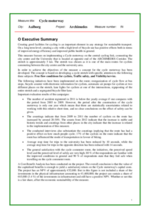Cycling motorway
Summary
Creating good facilities for cycling is an important element in any strategy for sustainable transport. On a long term level, creating a city with a high level of bicycle use has positive effects both in terms of improved energy efficiency and improved public health in general.
Implementing sustainable mobility
National figures suggest a decline in cycling in Denmark over the past few years. Aalborg is worried that the city is slowly following this trend as more and more students decide to travel around the city by car rather than by bike. The city wants to address some of the barriers to cycling in order to counteract this trend.
Aalborg will design a high-quality commuter cycling route between the city centre and the university. The overall objective of the measure has been to increase the number of trips made by bicycle and thus improve energy efficiency and public health. On a strategic level this means that the measure focuses on increasing the modal split of cycling amongst students and other people travelling along the corridor.
In order to achieve these objectives a concept for the cycle motorway has been developed. The concept is based on developing a cycle stretch with specific attention to the following three subjects:
- Free flow conditions for cyclist: The focus is on establishing a cycle stretch without unnecessary stops and detours. Recent Danish research has revealed that these factors are important in relation to the choice of the bicycle as a means of transport
- Traffic safety: The route should be a safe route for cyclist.
- Visibility and service: Providing cyclists with extra services is seen as a way to increase the attractiveness of cycling. In addition, these extra services are a way of making cycling visible across the city, and thereby to promote cycling.
These focus areas have been the prerequisites »in the «design of the route and the choice of the different initiatives on the route, financed by the ARCHIMEDES project.
Progress
The whole 5 km long stretch from the city centre to the university area has been rebuilt and upgraded from an ordinary cycle lane to a high-class cycle motorway. A dedicated bicycle track has been established for a large part of the route (approximately 2 km) combined with new solutions for cyclists at bus stops. The infrastructure work has been financed outside of the ARCHIMEDES project (an investment of approx. €1.2 million). The ARCHIMEDES project has contributed through staff time to design, plan and project manage the implementation of the measures, and by financing special equipment that is usually not part of a cycle path.
As the starting point for the work Aalborg initiated a workshop with stakeholders including cyclists and residents in the planning phase to generate new ideas and secure support for the measure. The focus of the project will be on accessibility, safety and granting visibility to cycling initiatives. Construction works started in autumn 2010.
The following innovative ARCHIMEDES initiatives have been implemented as part of the bicycle lane project
- Reorganisation of cycle flow at bus stops;
- Bicycle counter with electronic information for cyclists;
- Automatic air pump for cyclists;
- Lane lights for cyclists at one of the intersections;
- Signposting of the entire stretch; and
- A segregated bicycle filter lane.
Outcomes
Important evaluation results of the project:
- The number of accident registered in 2011 is below the yearly average if one compares with the period from 2005 to 2009. However, the period after the construction of the cycle motorway is only one year which means that there are statistically uncertainties related to working with this relative short time, and no clear conclusions on the effect of safety can be given.
- The countings indicate that from 2009 to 2011 the number of cyclists on the route has increased by around 20-30%. The counts from 2012 indicate that the increase is stable and historic trends and countings from other places in the city indicate that the increase is related to the implementation of this measure.
- The conducted interviews also substantiate the countings implying that the route has had a positive effect on how much people cycle; 17% of the cyclists on the route indicate that the route has influenced the mode of transportation in favour of biking.
- Average stop time for trips to the university has been reduced by 10 seconds, while the average stop time for trips in the opposite direction has been reduced with 14 seconds.
- The general satisfaction with the cycle commuter route, the initiatives, the perceived speed level and the perceived level of safety are very high; 80 % of the respondents are familiar with the improved conditions in general and 90 % of respondents state that they feel safe when travelling on the cycle commuter route.









